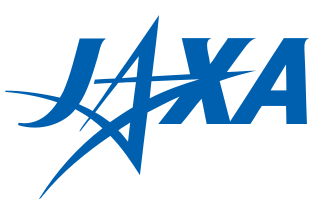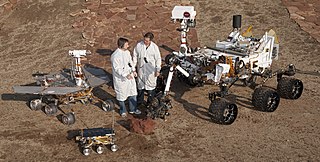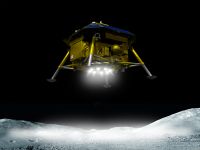
The Japan Aerospace Exploration Agency (JAXA) is the Japanese national air and space agency. Through the merger of three previously independent organizations, JAXA was formed on 1 October 2003. JAXA is responsible for research, technology development and launch of satellites into orbit, and is involved in many more advanced missions such as asteroid exploration and possible human exploration of the Moon. Its motto is One JAXA and its corporate slogan is Explore to Realize.

Atlas is a prominent lunar impact crater that is located in the northeast part of the Moon, to the southeast of Mare Frigoris. Just to the west is the slightly smaller but still prominent crater Hercules. Northeast of Atlas is the large crater Endymion.

A Moon landing or lunar landing is the arrival of a spacecraft on the surface of the Moon, including both crewed and robotic missions. The first human-made object to touch the Moon was Luna 2 in 1959.

A lunar lander or Moon lander is a spacecraft designed to land on the surface of the Moon. As of 2024, the Apollo Lunar Module is the only lunar lander to have ever been used in human spaceflight, completing six lunar landings from 1969 to 1972 during the United States' Apollo Program. Several robotic landers have reached the surface, and some have returned samples to Earth.

The following outline is provided as an overview of and topical guide to space exploration.

A rover is a planetary surface exploration device designed to move over the rough surface of a planet or other planetary mass celestial bodies. Some rovers have been designed as land vehicles to transport members of a human spaceflight crew; others have been partially or fully autonomous robots. Rovers are typically created to land on another planet via a lander-style spacecraft,tasked to collect information about the terrain, and to take crust samples such as dust, soil, rocks, and even liquids. They are essential tools in space exploration.

SELENE-2, or the Selenological and Engineering Explorer 2, is a cancelled Japanese robotic mission to the Moon that would have included an orbiter, a lander and a rover. It was intended as a successor to the 2007 SELENE (Kaguya) lunar orbiter.

Hakuto (ハクト) or formerly White Label Space (ホワイトレーベルスペース) was a team formed in early 2008 by a group of experienced space professionals inspired by the challenge of the Google Lunar X PRIZE to develop a robotic Moon exploration mission.

A lunar rover or Moon rover is a space exploration vehicle designed to move across the surface of the Moon. The Apollo program's Lunar Roving Vehicle was driven on the Moon by members of three American crews, Apollo 15, 16, and 17. Other rovers have been partially or fully autonomous robots, such as the Soviet Union's Lunokhods, Chinese Yutus, Indian Pragyan, and Japan's LEVs. Five countries have had operating rovers on the Moon: the Soviet Union, the United States, China, India, and Japan.
The (Japanese) Lunar Exploration Program is a program of robotic and human missions to the Moon undertaken by the Japanese Aerospace Exploration Agency (JAXA) and its division, the Institute of Space and Astronautical Science (ISAS). It is also one of the three major enterprises of the JAXA Space Exploration Center (JSPEC). The main goal of the program is "to elucidate the origin and evolution of the Moon and utilize the Moon in the future".

Smart Lander for Investigating Moon (SLIM), dubbed "Moon Sniper", was a lunar lander mission of the Japan Aerospace Exploration Agency (JAXA). The lander's initial launch date in 2021 was postponed until 2023 due to delays in its rideshare, the X-Ray Imaging and Spectroscopy Mission (XRISM). On 6 September 2023 at 23:42 UTC, XRISM launched, and SLIM separated from it later that day.

The year 2022 witnessed the number of launches of SpaceX's Falcon rocket family surpassing the CNSA's Long March rocket family, making the United States the country with the highest number of launches in 2022 instead of China. This year also featured the first successful launch of Long March 6A, Nuri, Angara 1.2, Vega C, Kinetica-1, and Jielong-3. National space agencies' activities in this year was also affected by the Russian invasion of Ukraine, which led to tensions between Roscosmos and Western space agencies, leading to threats of ending collaboration on the International Space Station (ISS), and resulting in several delays on various space missions.
ispace Inc. is a publicly traded Japanese company developing robotic spacecraft and other technology to compete for both transportation and exploration mission contracts from space agencies and other private industries. ispace's mission is to enable its clients to discover, map, and use natural lunar resources.
The Lunar Polar Exploration Mission (LUPEX), is a planned joint lunar mission by the Indian Space Research Organisation (ISRO) and Japan Aerospace Exploration Agency (JAXA). The mission would send an uncrewed lunar lander and rover to explore the south pole region of the Moon no earlier than 2028. It is envisaged to explore the permanently shadowed regions and to determine the quantity and quality of water on the Moon. JAXA is likely to provide the H3 launch vehicle and the rover, while ISRO would be providing the lander.

Spaceflight in 2025 promises to follow the 2020s trend of record breaking orbital launches and increased developments in lunar, Mars and low-earth orbit exploration.
The Emirates Lunar Mission is the first mission to the Moon from the United Arab Emirates.

Hakuto-R Mission 1 was a failed private Japanese uncrewed lunar landing mission built and operated by ispace, which was launched in December 2022 for an attempted lunar landing in April 2023.

Hakuto-R Mission 2 is a robotic lunar landing mission launched on 15 January 2025 at 06:11:39 UTC. Developed by ispace, the lander will deliver a new micro rover manufactured by the company, as well as other payloads. Like Hakuto-R Mission 1, this mission will serve as a technology demonstration, with the final goal of providing reliable transportation and data services on the moon. The lander is named Resilience.















